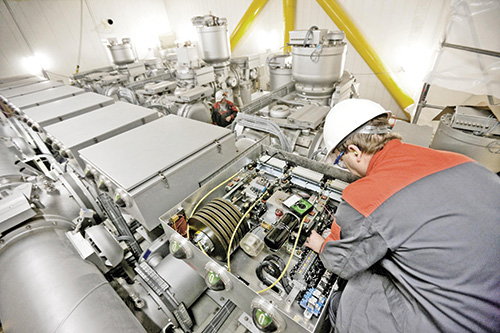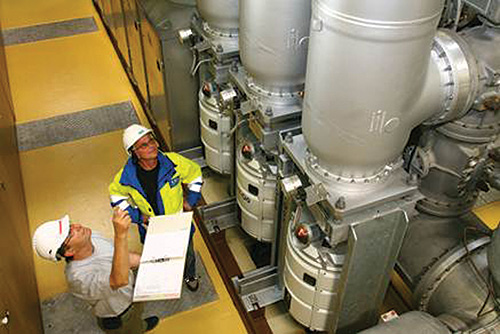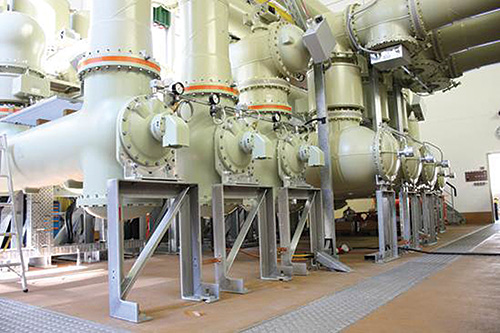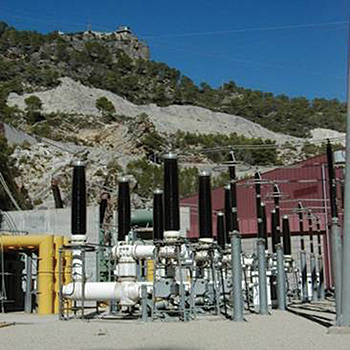
High-voltage circuit breaker equipment represents a substantial investment for any utility, especially when coupled with today’s sophisticated new grid technologies. So when it comes to maintaining or replacing these breakers, all options have to be considered. Often, the most cost-effective option is to partner with a full-service OEM expert who will employ the latest technologies during maintenance cycles and seek life extension opportunities, such as retrofits or component replacement.
In some cases, total replacement, removing obsolete equipment or technology, may be best. Remote monitoring and advanced inspection techniques, such as radiography, will often eliminate the need for intrusive maintenance programs, or early replacement altogether.
There are several well-developed service strategies available today to suit the many different maintenance and replacement scenarios encountered in the high-voltage circuit breaker world.
To retrofit is to exchange worn parts or outdated components while maintaining the original plant and equipment configuration. Often, in a substation, original equipment, such as the housing and busbars, remains in good condition over many years, and it is only the moving circuit breaker parts that need to be replaced. Mechanical equipment wears out long before stationary assets. Retrofitting extends service life without the high costs, major disruption and extended time scales associated with a complete replacement project. The work can also be staged to spread out cost and minimize disruption.
Often, a new breaker will not be compatible with old equipment. In such a case, an OEM or supplier will provide special conversion kits that enable quick installation without structural modifications to the original setup.
Many of today’s breaker and drive retrofits ensure that the client receives long-term equipment reliability with the latest technology and minimal outage time – all at a reasonable cost.
Retrofit examples
ABB has supplied several clients with replacement breakers for their gas-insulated switchgear (GIS) instead of revision solutions. Invariably, the replacement breaker was of a newer type and the flange distance and other parameters had to be matched. For example, in the Netherlands (Rijswijk substation) and in Switzerland (Katz substation) first-generation GIS ECKS breakers were successfully replaced with ELK SP 2-1 breakers and AHMA drives. The motivation for the replacement was dwindling repair expertise and the increasing difficulty experienced in sourcing spare parts. In the La Foretaille substation in Switzerland, a similar replacement was undertaken (in this instance an ELK SN breaker type was replaced by ELK SP 2-1), the motivation here being impending high overhaul costs (See Figure 1 > 1).

Fig 1: La Foretaille GIS substation in Switzerland.
The older-generation circuit breaker type SN was replaced by an ELK SP2-1 with AHMA drive.
Not all older breakers have a new equivalent. However, there are a few new retrofit breakers in the power industry that could replace older breakers of types SL211, SL2-2, SN212, SL3-2 and SN312. Most of these have been type tested as per the latest applicable standards and are manufactured in the controlled environment of a factory.
The EGL 380 kV substation at Filisur, in Switzerland, is the first substation in the world to have such a specifically developed retrofit breaker installed (See Figure 2 > 2). The utility had originally considered overhaul of their HKA 8 drive, but decided instead to install the new HMB 8 drive. They also replaced their complete SL3- 2 breaker and drive with a newly developed retrofit SP 3-1 breaker. This new breaker has only one single arcing chamber – representing state-of-the-art GIS technology – and therefore needed only a (smaller) HMB 4 drive. The utility quickly opted for this proposal – extended substation life, continued availability of spare parts and lower maintenance costs being the convincing arguments. The actual circuit breaker exchange at the site took only two days and the switchgear resumed normal operations with minimal downtime.

Fig 2: Filisur GIS substation, Switzerland. The SL3-2 circuit breaker and HKA8 drive
were replaced by a single chamber SP3-1 circuit breaker with HMB4 drive.
One alternative to changing the complete circuit breaker and drive is to change only the drive itself. Iberdrola recently opted for this. In Spain, at the La Muela pumped storage substation, a retrofit drive solution was developed for Iberdrola to replace the old HKA 8 drive on a SL 3-2 breaker (See Figure 3 > 3). The HKA drive was dismounted from the breaker pole and a new HMB 8 drive was fitted, with necessary adjustments (damping). The homologation tests were conducted onsite. Satisfied with this solution, Iberdrola decided to implement the same retrofit drive solution in the remaining bays at the same substation. And similar drive replacements were made in the Seinäjoki and the Tammisto substations in Finland.

Fig 3: La Muela GIS substation, Spain.
The HKA8 drive was replaced with the HMB8 on SL3-2 circuit breaker.
Extension, Upgrades and Retrofits
Today’s OEM’s and service providers have developed a variety of cost-effective upgrade, extension and retrofit programs that enable extremely low-risk and phased migration to the latest technologies. After a complete site evaluation, most providers will develop a customized implementation plan for migration of the installed equipment.
One good example of this centers on the delivery of two 132 kV gas-insulated ELK-04 switch-bays to the 30-year-old Al Bakir transformer substation in Iraq. This investment became imperative in light of the growing power demand caused by the construction of a steel factory nearby and to be able to adequately interface to the Iraqi grid.
The primary deciding factor was that the ELK-04 design could be adapted to fit into the restricted space available. The utility received competent consulting support during the engineering stage and now has a reliable 132 kV substation, security of energy supply and guaranteed personnel safety. The previous infrastructure was kept intact, and further extension is now simplified, thanks to the use of standardized adapters.
Asset optimization in New York
Industry needs are changing as resources become limited. As a result, established consulting services for and engineering expertise in remote monitoring of all critical substation diagnostic metrics have come into play. One such service combines ABB’s universal breaker monitor with deep operational and diagnostic expertise to provide real-time asset optimization and to allow remediation prior to failure.
This approach was taken recently within New York’s electrical power grid, which is highly dependent upon the health and reliability of the high-voltage cross-state ties between the NYISO’s transmission owners, such as the 362 kV lines connecting Rochester Gas and Electric (RG&E) with New York Power Authority. To help enhance the reliability of this transmission corridor, RG&E has equipped its type PMI capacitor bank breakers, which support the critical east-west tie, with real-time remote condition monitoring, and has also instituted proactive maintenance practices. Of particular interest for first-trip analysis of the transmission line breakers was acquiring a means of recording all trip and close operations, as well as the timing statistics, of those breakers.
The company equipped a fleet of 18 RG&E 121 kV and 362 kV PMI breakers with the asset optimization (AO) system. The system monitors a myriad of breaker status and performance parameters via wireless communication. Data from each breaker is gathered by a proprietary circuit breaker sensor called CBS. Each CBS has been paired with a cellular communicator – decidedly the most cost-effective means of delivering data to a central office, especially from substations lacking a network structure. The CBS-based monitoring approach was especially appealing to RG&E since the units and their wireless communication architecture function independently of the utility’s transmission line operating and control system. That separation exempts the monitoring system from NERC-CIP (North American Electric Reliability Corporation’s Critical Infrastructure Protection plan) requirements. The accumulated CBS data is processed at RG&E’s central office by the AO system, which delivers real-time, independently accessible data to detect circuit breaker health and performance conditions before a failure occurs. The AO system thereby assists circuit breaker problem diagnosis and offers corrective recommendations. Its alerts vary in complexity from identifying status changes in an intelligent device to identifying abnormal conditions. The system includes an independent ABB redundant archiving system to ensure reliable storage of long-term data. With this reliability improvement RG&E was able to obtain a rate increase from the local regulatory commission.
Radiography
Radiography is an x-ray imaging technology, employed here in an external environment that captures detailed digital images of a circuit breaker’s critical internal components. These images are then reviewed by OEM experts, who check dimensions and tolerances against original component and assembly drawings. Radiography eliminates the need to breach the sealing system of the equipment being diagnosed, thus increasing equipment reliability and making infiltration of external contaminates a nonissue.
Call Henry Inc. is the high-voltage on-site support service contractor at the NASA Glenn Research Center in Cleveland, Ohio. The Center leads NASA’s research and development in the area of aero-propulsion and specializes in turbo-machinery, power, propulsion and communications, while also conducting research in various microgravity science disciplines. Obviously, power supply reliability is critical to such a facility.
In February 2006, Call Henry contacted ABB on behalf of the center regarding the health of their 26 ABB 38PM40-20 SF6 power circuit breakers. A review of the maintenance data carried out by the center and Call Henry highlighted the fact that many of the center’s circuit breakers were between 10 and 14 years old, with one breaker having completed over 2,700 operations during its lifetime. It was apparent that these breakers were working hard and were due for an internal inspection.
A site visit was coordinated between the center, Call Henry and ABB in order to perform the inspection. The work scope consisted of external diagnostics testing, heavily featuring the use of radiography. The driver for this approach was a desire for cost and outage time reduction, while certifying the long-term integrity of each breaker and, more importantly, its power supply. The radiographic inspection resulted in entry being made to one breaker to remediate a hardware problem and reduction of the SF-6 gas moisture content in seven others. Nineteen were spared any entry or intrusive maintenance whatsoever and over 380 man-hours of intensive, internal inspections were saved. A crane, with operator, and gas cart rental were also saved.
The external diagnostic testing and resulting maintenance ensured continued and reliable operation of the center’s fleet.
Replacement
Equipment can be completely replaced at the end of its service life, or if better technology has become available. In the case of generator circuit breakers (GCBs), upgrading the turbine and generator will also necessitate the replacement of the GCB. GCBs may also be replaced if obsolescence results in non-availability of spare parts or inadequate engineering solutions.
One example of this concerned the spring-loaded hydraulic circuit breaker operating mechanisms in five transformer substations in Kuwait City, owned and operated by the Kuwaiti Ministry for Electricity and Water (MEW). Considering the increasingly critical spare parts situation for the existing operating mechanisms, which are nearly 30 years old, the proposal to replace the existing units with 48 HMB-8 operating mechanisms was positively received by the MEW. An essential aspect of this decision was quality assurance and the guaranteed availability of the related spare parts. As a result, the MEW acquired a dependable spare parts supply, high substation availability and reliability, better personnel safety, uncomplicated adaptation and replacement, and, of course, a simplified operation.
About the Author
 Monica Lambe is a Market Analyst with ABB in the High Voltage Service business, a part of the High Voltage Products business under ABB’s Power Products division. Monica is based in Mount Pleasant, Pennsylvania and Zurich, Switzerland, and has served in various roles at ABB over the past 10 years. She can be reached at: monica.lambe@ch.abb.com.
Monica Lambe is a Market Analyst with ABB in the High Voltage Service business, a part of the High Voltage Products business under ABB’s Power Products division. Monica is based in Mount Pleasant, Pennsylvania and Zurich, Switzerland, and has served in various roles at ABB over the past 10 years. She can be reached at: monica.lambe@ch.abb.com.







